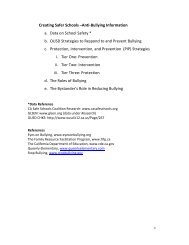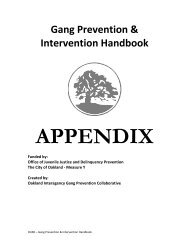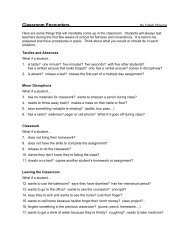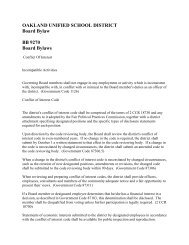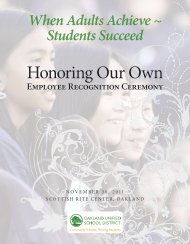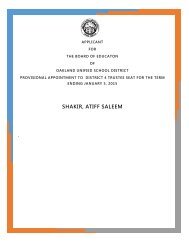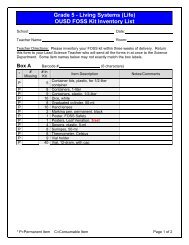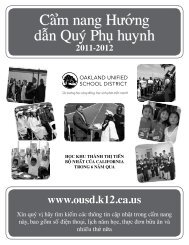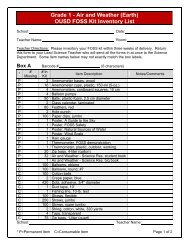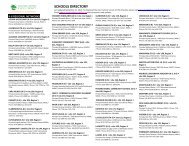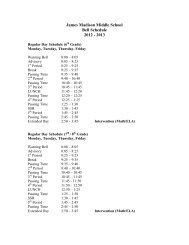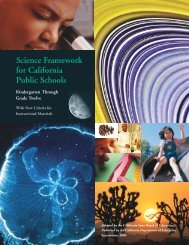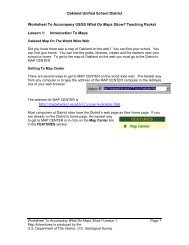Oakland Unified School District Case Study
Oakland Unified School District Case Study
Oakland Unified School District Case Study
Create successful ePaper yourself
Turn your PDF publications into a flip-book with our unique Google optimized e-Paper software.
The school’s schedule calls for a blend of<br />
whole class and small group work. For 2<br />
days per week, explicit teaching and modeling<br />
takes place using the OCR anthology<br />
of stories. In the whole class reading and<br />
discussion of the stories, reciprocal teaching<br />
strategies are utilized. 13 The teacher explicitly<br />
teaches and models the key reading<br />
skills/standards for the week, so the whole<br />
group reading instruction additionally provides<br />
an explicit scaffold for small group<br />
reading later in the week.<br />
The literacy program also maintains continuity<br />
between whole group instruction<br />
and small group instruction by continuing<br />
to focus on the same skill while varying<br />
the teaching strategies. For example, if<br />
the objective of the week is for students to<br />
know and be able to compare and contrast<br />
two pieces of non-fiction text, then during<br />
whole group instruction, the teacher<br />
will use the Open Court story and a Venn<br />
diagram to model and lead students in<br />
guided practice in the skill “compare and<br />
contrast.” During small group reading<br />
instruction, students apply the reading skill,<br />
“compare and contrast,” to what they are<br />
reading at their reading level. Small group<br />
reading instruction occurs at least three<br />
times per week, using different reading<br />
strategies based on student grade level. 14<br />
All planning, delivery of instruction, and<br />
assessment is geared toward mastery of<br />
grade-level standards utilizing a depth-overbreadth<br />
approach. Each week, a gradelevel<br />
reading skill is taught for mastery. 15<br />
Teachers model the reading skill with text<br />
that the whole class is reading; then teachers<br />
engage students in guided practice with<br />
the same reading skill; then students apply<br />
the skill to what they are reading in small<br />
groups with their reading level text. As<br />
teachers instruct for a particular reading<br />
skill to be taught to mastery, this reading<br />
skill is practiced in reading application as<br />
well as small assignments geared at written<br />
application. For example, if the reading<br />
skill for a particular grade level in a week<br />
is to compare and contrast two characters,<br />
explicit modeling, guidance and application<br />
occurs when students write a short essay<br />
comparing and contrasting two characters<br />
from what they are reading. 16<br />
Now, when one walks into classrooms at<br />
AWE it is evident that students are actively<br />
engaged in learning. When observing a fifth<br />
grade classroom, we observed all students<br />
in small groups working on the same skill<br />
— drawing conclusions — but using different<br />
texts depending on the reading level of<br />
each small group. The teacher visited every<br />
group and encouraged them to follow a<br />
protocol for reciprocal teaching. The next<br />
day, each student read a book at his or her<br />
own level, so that a particular student was<br />
working on mastering a fifth grade language<br />
arts standard in a third grade book.<br />
The teacher rotated throughout the class<br />
and helped students when necessary. Upon<br />
completion of the book, the teacher had the<br />
students take an Accelerated Reader 17 test.<br />
AWE teachers also use a reading buddy<br />
program to promote students engaging with<br />
texts in meaningful ways. In this program,<br />
older students are assigned a buddy in a<br />
lower grade with whom they read each<br />
week. Both the younger and older students<br />
feel this program helps improve their reading<br />
skills, as the older students are motivated<br />
to master the text to explain it to<br />
younger students, and the younger students<br />
understand the text better after receiving<br />
instruction from the older students. Many<br />
students identified the reading buddy program<br />
as one of their favorite aspects of the<br />
ELA program at AWE.<br />
OUSD <strong>Case</strong> <strong>Study</strong>: ACORN Woodland Elementary 11



